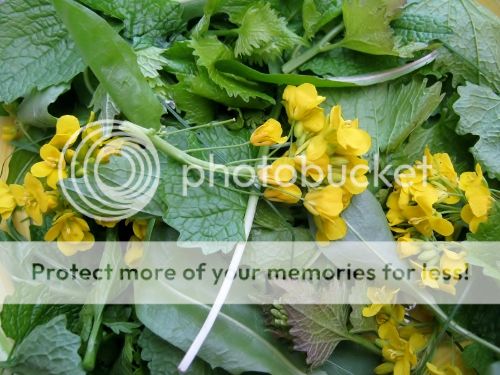“And Spring arose on the garden fair,
Like the Spirit of Love felt everywhere;
And each flower and herb on Earth’s dark breast
Rose from the dreams of its wintry rest”
Percy Bysshe Shelley, The Sensitive Plant
Visiting the gardens for the first time this spring, admiring the tidiness, the good order and the obvious endeavour of the members in early planting. Tantalizingly, the young edibles were hidden from sight and reach, secure under cloches. Future abundance!
What to eat now? Chard had persisted through the winter with its bright veins and broad leaves. And, something else was available. Plants growing without – despite human intervention.
Wild greens. In an uncultivated bed nettles, dandelion, cleavers had thrust forth out of the soil. No protection required! These uber resilient species are understandably a gardeners nightmare, and acknowledged and respected for their contribution to diet and ecology. Juliet is a wild greens enthusiast and understands their value. But I had a feeling that eventually these plants would be evicted to make room for summer veg.
I was pleased to see them. In perfect configuration, the ingredients for a wild green juice as a spring tonic to cleanse and re-energize after the quiet rest of winter and banish any lingering sluggishness. Crouching to gather, I was thrilled to discover a clump of chickweed, its tiny white flowers like points of light – hence the latin name stellaria. Fantastic in salads. I helped myself.
Out and about beyond the gardens, wild greens are abounding, prolific in lanes, fields and footpaths. This morning: flowering tops of garlic mustard or Jack-in-the-Hedge, baby dandelion leaves, and unexpectedly a pair of feral cabbages with bright yellow flowers good for salad and more leaves to add to juice.
Such an innocent pleasure to pick food for free and be uplifted by signs of spring all around: delicate violets, a ladybird sunning itself on a grass stem. Shoots and buds of all kinds bursting open and greening treetops bouncing joyfully in the wild air.
It is said that wild foods contain our ‘medicine’: the specific information, nutrients and co-factors our cells require to maintain balance and harmony. Thus, consuming wild foods can significantly boost health and wellbeing as we transition through the changing seasons.
It is further suggested that those plants we are most in need of will be those growing most freely and most proximate. So for many of us, that means nettles, nettles and more nettles, a dietary staple in the British Isles for hundreds of years, (though maybe not indigenous, possibly a Roman import.)
It is easy to deduce why we have evolved our diet from a mostly foraged food supply towards agriculture and hybridisation. Not only can wild plants to be fierce to handle; their bitterness can be a challenge to our coddled palates. Contrast nettles, thistles and brambles to butter head lettuce and spinach!
Over time we have tended to select for greens that are softer in texture and milder in taste. It is worth persisting and welcoming the more pronounced flavours, eventually we neuro-adapt not only tolerate, but to relish and prefer them!
It is good to pick while shoots are young and contain maximum life force. Soon, the energy of growth and the nutrition will transfer from leaf to stem, to flower and then to seed. So let us collect plenty of nettle tops now! We can dry, store and use them later in the year.
Fortunately, when this glorious wild flush is over – a mere matter of weeks, the salad leaves in the gardens should be well established and productive. And we shall enjoy fresh raw greens with all the pleasure and vitality they confer throughout the months to come.

Wild greens spring salad
